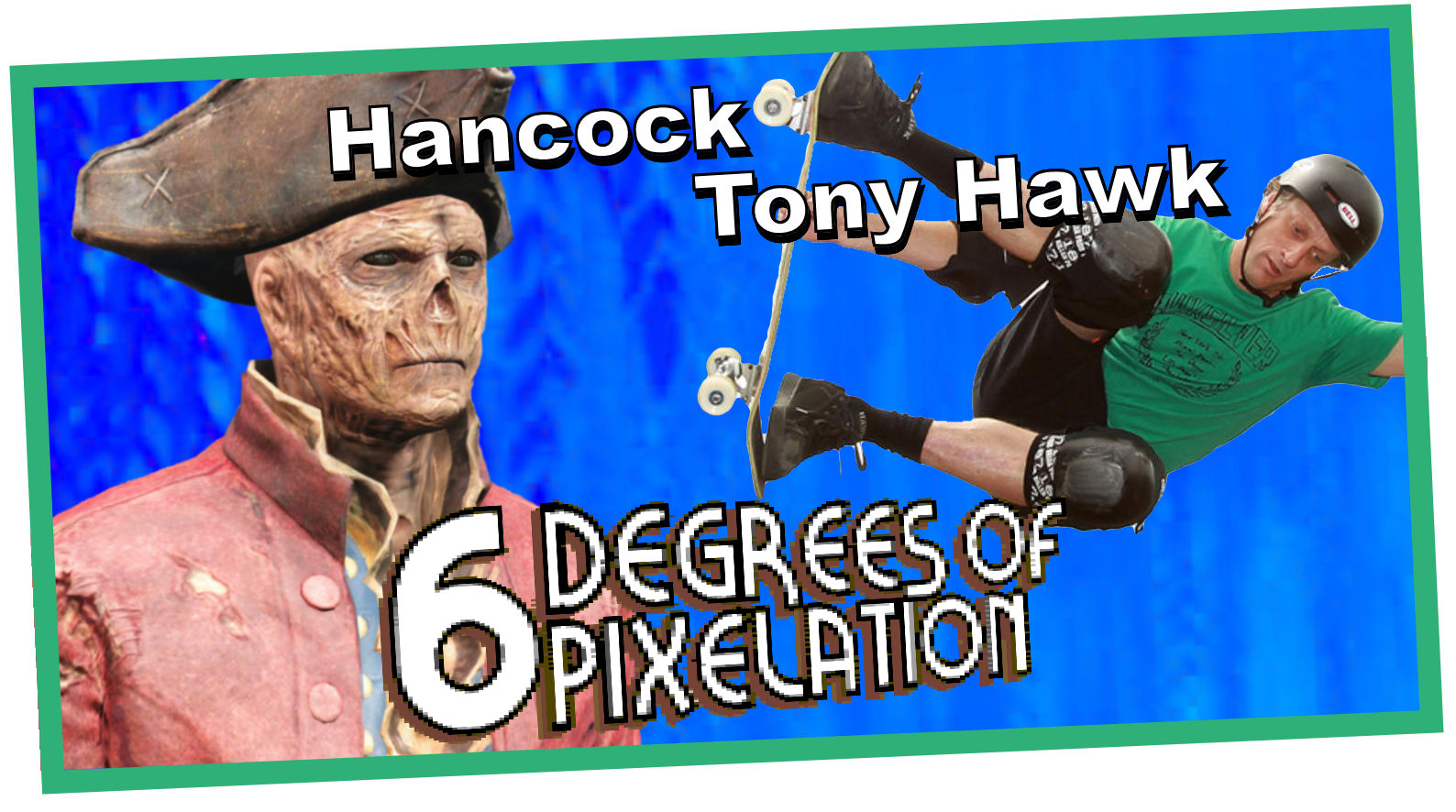How are Hancock from Fallout 4 and Tony Hawk connected? | 6 Degrees of Pixelation [VIDEO]

Today I connect Hancock—the gruff-voiced ghoul mayor of Fallout 4’s Goodneighbor—with Tony Hawk—the famous skateboarder and titular star of many Tony Hawk’s Pro Skater games.
You know that social theory that everyone on earth can be connected to anyone else by no more than 5 intermediaries? They call that 6 Degrees of Separation. I do the same thing here, except I connect video game topics in strange ways using 6 Degrees of Pixelation.
Google Docs Research/Sources/Credits/Inspiration
https://docs.google.com/document/d/16TE7hsBLmC0Wt45lS3trJUTV-1LopnE8Ay0-eh3jWs8/edit?usp=sharing
Full Transcript
Welcome to 6 Degrees of Pixelation, the show that leverages the facade of a respected social theory–6 degrees of separation–to bring you what amounts to a video game and pop culture trivia dump. I’m Caleb. This is my office, and that is a throwing star target I made out of a closet shelf when I was in 7th grade. My mother wasn’t happy about that.
Today I’ll be connecting Hancock and Tony Hawk, a pair that is as unrelated as it is fun to say. Hancock is the smooth-voiced ghoul mayor of Fallout 4’s conspicuously named neighborhood of Goodneighbor, and Tony Hawk of course played the integral role of “guy answering phone” in 1989’s Gleaming the Cube…he was also involved in real skateboarding.
Let’s get right into the first connection:
1-Hancock > Tom Waits Scroll
When Fallout 4 was released, Hancock quickly became a fan favorite character, with his casual demeanor and generally optimistic attitude. He’s the mayor of Goodneighbor, a refuge for the downtrodden in the commonwealth where citizens must abide by one rule above all others: no judgement. Except of course when you must judge others for their own judgement, but that’s a nuance even real life can’t navigate so how would we expect a post-apocalyptic, hellscape videogame to do it? Yes, I understand that videogames can be sandboxes to put our real-life social theories into practice, so by that logic videogames should be better equipped to explore a world of non-judgement. But when our real world is so imbued with judgement, making a videogame to explore a world without it, is impossible for the bulk of humanity to comprehend. So, fuck you Finn.
In addition to Hancock’s demeanor and attitude, we’re also drawn to his voice. It’s gruff yet soothing, and quite unique. So unique in fact that it resembled only one other voice I could think of. I immediately got a Tom Waits vibe from Hancock. And for those of you who watch my let’s plays, you may have noticed a couple posters of the musician on my office wall. I’m a huge Tom Waits fan, so the possibility of Tom Waits existing in a Fallout game intrigued me to say the least. So intrigued in fact that I asked Danny Shorago, Hancock’s voice actor and the front man for the band The Fuxedos, about the connection. Mr. Shorago all but confirmed the influence by posting a video of himself performing a cover of Waits’ “Step Right Up.” Hole-ee-shit indeed, Caleb.
But that’s not the only time Tom Waits has inspired a videogame asset…
2-Tom Waits > Diablo scroll
I’ve always believed that it’s kinda hard not to be influenced by Tom Waits. I know much of my creative output has been inspired by the man (including this video; I basically just wanted a reason to talk about him). I’d play one his songs for you, so you can experience the unique gruff nature of his voice and the somewhat vaudevillian quality to his music, but sadly Tom Waits has also inspired many lawsuits, so instead I’ll play this clip of a buster keaton movie overlaid by the sound of a tiger growling with a rhinoceros yelp layered in for the high-notes…yep, that’s pretty close.
The Diablo series is also a much-beloved inspiration. With its focus on hack-and-slash, role-playing mechanics, dark atmosphere, and semi-randomly generated dungeons, it would be hard to isolate a contemporary role playing game that hasn’t felt Diablo’s influence. So, it seems logical then that one of these great inspirations would inspire the other.
Matt Uelmen, the sound designer for the Diablo series, has stated that Tom Waits, played a role in inspiring him to become a composer. Tom Waits is actually thanked in the Diablo game manual. Such inspiration eventually lead to Uelmen’s Diablo II soundtrack composition, which was recognized with the inaugural Excellence in Audio award by the International Game Developer’s Association (IGDA) in 2001.
It’s a good thing a terrible Justice League game was ported to the SNES, otherwise we may never have had Diablo…
3-Diablo > Justice League scroll
Justice League Task Force is 2D fighter developed by Condor Games and released for the Genesis in 1995. This game is unremarkable in every way, suffering from lag issues, uninspired design, and an the unintended desire to just play Street Fighter 2 instead.
Admittedly, the game is impressive for a couple reasons. 1) You can beat Superman with Green-Arrow. I’m not a comic book guy, but that just seems weird. 2) It’s not the shittiest game Superman has ever appeared in. That award goes to Superman 64, a game awful for many reasons, but perhaps one of the primary reasons being that, according to the game’s producer Eric Caen, the licensor was extremely difficult to work with and refused to let Superman kick “real” people. Lack of human violence isn’t inherently a bad thing, but this restriction forced the game to adopt a virtual world environment which likely played a role in the game’s demise.
Back to Justice League Task Force. At the time Blizzard was a little-known developer, and one way to show your chops to the gaming world is to work on shitty licensed games. So that’s what they did, porting Justice League Task Force to the SNES. This relationship between Condor and Blizzard spawned what would become Diablo. One thing I’m very happy about is that Blizzard didn’t take inspiration from one of the late game bosses of Justice League Task Force, a half cheetah half woman character named Cheetah. Thank you Blizzard for not including a cheetah woman in your game. I don’t need another game encouraging me to consider beastiality.
Besides, including a superhuman cheetah person in a game is practically a death knell.
4-Justice League > Cheetamen scroll
Justice League Task Force is, at best, a mediocre 2d fighter. It would be a stretch to call fellow-cheetah-featuring game, The Cheetahmen, mediocre in any respect. It is, to some players, the worst NES experience ever. Not only are the visuals atrocious, but the hit detection is inconsistent–it’s too generous sometimes and at other times way too restrictive, the scrolling is pesky in that it requires arbitrary events to be triggered in order to function (like here, I can’t climb up this ladder until I knock the screen just a few more pixels to the right), and the game locks up constantly, forcing the player out of the terrible 2d action facade into a maraca based dance simulator. Hey maybe I can connect The Cheetahmen to Dance Dance Revolution in a future 6 Degrees of Pixelation episode…
The Cheetah Men was sold as part of Action 52 from Active Enterprises, a collection of 52 games on a single cartridge. This type of bulk game curation historically insists on a fair amount of shovelware, hoping to bank on the quantity over quality mentality of gullible consumers. But when even the collection’s showcase game is this bad, the rest of the games have even less of a chance of being playable. The Cheetahmen was supposed to be Active Enterprise’s response to the Teenage Mutant Ninja Turtles. At least they got the Martial Arts + animal + historical figure namesake formula down. Here we get Apollo, the greek god of music; Hercules, the greek demigod; and Aries, the ram constellation (I guess because there isn’t a Cheetah constellation). All we’re missing is Pan, the greek god of fucking everyone. Really, he’s not just interested in goats, as you may have learned in school.
Active Enterprises continued to Pan-fuck it’s customers even beyond The Cheetahmen. The company advertised a competition in which anyone capable of completing level 8 of Ooze, another side scrolling affair on the Action 52 cartridge, would be entered into a prize drawing to win over $100,000. The problem is that game reportedly crashed on level 2, making this prize impossible to win. I say “reported to crash”, as I couldn’t verify this crash, because I couldn’t even get past the first jump obstacle on level 1. And I know how to jump in video games. I’ve done it several times over the years. This game simply doesn’t work.
Developers who purposefully screw over their customers should be ashamed of themselves. Good thing it never happened again…of course it happened again.
5-Cheetahmen > Tony Hawk scroll (Pro Skater 5)
Tony Hawk’s Pro Skater is a game that in many ways defined what a sandbox game could be. The first installment of the series was released in 1999, two years before Grand Theft Auto III, which many consider to be the grandfather to open-world gameplay.
It’s hard to overstate just how much this game grabbed people. I remember playing a demo of the game, distributed by Pizza Hut on a Playstation demo disk, for hours. This was just the first Warehouse level of the game, a level that is absolutely archaic by today’s standards. Imagine, a single level, a 3 minute time limit, and repeat until morning. And this magic remained bottled for a few more games in the series.
But then came Tony Hawk’s Pro Skater 5, a game that was sold to customers without there actually being a game at all. Let me explain. In 2000, Activision bought the rights to make Tony Hawk games for the following 15 years. As these rights were impending expiration in 2015, Activision wanted a way to continuing milking its customers for money, but they didn’t have a Tony Hawk game ready to go. So they took parts of the 2012 Tony Hawk’s Pro Skater HD game, and managed to weasel a fifth installment out of it, releasing it on the very last day that they held the rights. Well that was close, they made a masterpiece just in the knick of time, right? Not quite.
The only thing ready on the day the game had to be submitted to be manufactured, distributed, and pulled over bureaucratic hurdles was a tutorial level. But that didn’t stop Activision. They released the disk anyway, then, using that manufacturing, distribution, and bureaucracy time I just mentioned bandaged the proper game as much as they could. When the game actually hit shelves, Activision simultaneously released a 7 ½ gigabit “patch,” which, as you can imagine, wasn’t a patch at all, but was instead the entire rest of the game. And those bandages I mentioned, they didn’t fix much. Even with the massive patch, the game was glitchy, buggy, and overall a far cry from the Pizza Hut demo disk experience I remember…
* * *
This has been 6 Degrees of Pixelation, from Hancock to Tony Hawk.
If you enjoyed this video, please give it a thumbs up. I’d like to turn 6 Degrees of Pixelation a legitimate series, and the more positive feedback I receive, the more likely it is to happen. Share the video with your gaming and trivia nerd friends.
You’ll find a link in the description to a Google Doc with my script, notes, and sources so you can dig in more if you’d like.
And don’t forget to subscribe. I do trivia videos like this, let’s plays, and think pieces. Think pieces are my favorite, but they just take a bit more time, so I fill the otherwise empty days with the aforementioned video types.
Until next time, I’m caleb, you’re someone who needs Tom Waits in your life, and we are Burning Books.
Research/Sources/Credits/Inspirations (this is not a comprehensive list, as that would be impossible, especially the “inspirations” items)
- “Chapter 7 – Fallout 4 Gameplay Playthrough” by Silent Gamer and Musician is licensed under CC BY 3.0
- “How to get Hancock as a Follower/Companion – Fallout 4” by RejectedGamingII is licensed under CC BY 3.0
- Interview With Matt Uelmen: http://www.rpgamer.com/news/Q1-2001/021901b.html
- Interview with Eric Caen: http://www.protonjon.com/blog/?p=48
- 15 Fascinating Facts You May Not Know About ‘Diablo’: http://uproxx.com/gammasquad/15-fascinating-facts-may-know-diablo/
- “(#SGAChallenge) Smosh Games Alliance Challenge Episode 2: Justice League Task Force” by RageBad MyOwnRageShow is licensed under CC BY 3.0
- 5 Purposely Broken, Unbeatable Games by Dickish Developers | Fact Hunt: https://www.youtube.com/watch?v=0mn-4y8YrU4
- “Tony Hawk’s Pro Skater 5 – New Gameplay with New Soundtracks Leaked” by Tales Of Stories is licensed under CC BY 3.0
- http://www.techtimes.com/articles/111655/20151130/tony-hawks-pro-skater-5-latest-patch-brings-additonal-levels-new-character-campaigns-and-more.htm
- http://www.eurogamer.net/articles/2015-11-27-tony-hawks-pro-skater-5-has-finally-been-updated
- http://www.gamespot.com/articles/tony-hawks-pro-skater-5-gets-78-gb-patch-see-all-t/1100-6432635/
- By Tinou Bao – originally posted to Flickr as Bob tony hawk, CC BY 2.0, https://commons.wikimedia.org/w/index.php?curid=6011911
- “Matt Chat 149: Diablo” by Matt Barton is licensed under CC BY 3.0
- By Paula Wirth – originally posted to Flickr as [1], CC BY-SA 2.0, https://commons.wikimedia.org/w/index.php?curid=7919456
- “JCF Test: Superman – Nintendo 64 (Project64)” by sergentvilo is licensed under CC BY 3.0
- By Marie-Lan Nguyen (2011), CC BY 2.5, https://commons.wikimedia.org/w/index.php?curid=16965691
- By Walter Crane – The story of Greece : told to boys and girls (191-?) by Macgregor, Mary, Public Domain, https://commons.wikimedia.org/w/index.php?curid=32804561
- Green Gamepad background: http://www.movietools.info/
Music Credits
- Rhinoceros Kevin MacLeod (incompetech.com), Licensed under Creative Commons: By Attribution 3.0 License, http://creativecommons.org/licenses/by/3.0/
- Overworld Kevin MacLeod (incompetech.com), Licensed under Creative Commons: By Attribution 3.0 License, http://creativecommons.org/licenses/by/3.0/


